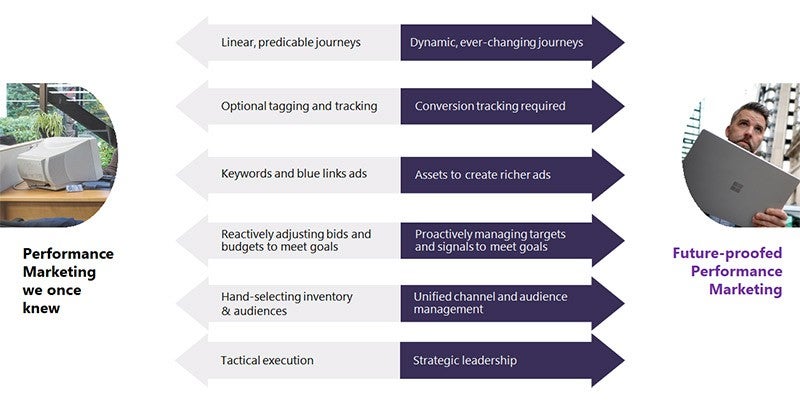ブログ投稿
Making automation work for you

The performance marketing landscape is changing rapidly due to fast-evolving technology and economic conditions. Volatility and diminishing resources are the new normal, which is driving a major industry push toward automation. You may feel pressure to embrace more automation, but there are important limitations that can’t replace your strategic leadership. Navigating these new technologies while making your strategic thinking and creativity shine is what will differentiate performance marketers.
The evolving leadership role of performance marketers
Technology is changing all jobs. A key skill in the modern economy is to differentiate where artificial intelligence (AI) adds value and where people should lead to optimize them both working together. AI-led automation should be strategically applied to areas that allow:
- Saving resources by automating manual and repetitive tasks, so people can better allocate time in strategic areas, like being closer to customers.
- Making real time decisions and optimizations with large amounts of unstructured data, improving agility and being ahead of competitors.
The role of performance marketers continues to evolve into a much more strategic one:

Microsoft AI by your side, following your lead
We are at an inflection point in the industry and AI is the new wave of computing. That said, nobody knows your business goals and customers better than you, so AI is there to follow your commands, not the other way around. Here at Microsoft Advertising, we think about the A in AI as “Augment”, by freeing you to focus on what matters and by augmenting the impact of your decisions.
You are in control of the outcomes
To make automation work for you, we need to push the right buttons. We do that by giving it quality signals and clear directions of what performance truly means for us. It’s our input as marketers that controls the system, and its quality is what makes the difference. There are two major tectonic plates moving in the industry: AI and privacy eliminating old signals. When these two plates collide, those catapulted to the top will be the ones doing a better job feeding the system with stronger first-party data. Market share is going to be captured by those who strategically leverage partners with strong 1P data (like Microsoft’s massive intent, 1P data), and add their own signals with these five activations.
The five critical activations needed to be executed better than our competitors are:
- Tracking
- Set up the Universal Event Tracking (UET) tag across your website with accurate Conversion Tracking.
2. Goals
- Select an optimal Automated bidding strategy, since conversion-based strategies are recommended to enable target setting.
- Set secondary goals beyond the single conversion, such as website engagement.
- Explore using automated rules and performance insights to easily monitor fluctuations and optimize if necessary.
3. Assets
- Add assets like image extensions.
- Add different copy inputs.
- Keep feeds updated.
- Review and implement Microsoft Advertising’s recommendations to infuse AI-generated suggestions.
4. Targeting
- Check your targeting settings and make sure you give space for discovery.
5. Placements
- Audit website exclusions to refine, remove old exclusions, and let the algorithm find your best audience across the inventory.
These should not be seen as checkboxes—it’s not only about their quantity but also about their quality.
Getting better ROI
When we combine Microsoft’s intent and audience data with your signals, our leading AI capabilities can bring the return on investment (ROI) you set, adjusting with agility during uncertain times, as the numbers show:
- Cost per acquisition (CPA) of search campaigns extended to the Microsoft Audience Network has reduced by 40% relative to search.2
- Embracing enhanced cost per click (eCPC) at similar spend levels enabled a 20% increase in search ROI3 vs. the former deprecated manual bidding on search.
- Conversion rate (CVR) increased by 11% and CPA decreased by 5%1 for those using eCPC vs. manual bidding on the Microsoft Audience Network.3
- Those who have transitioned the same assets from their Expanded Text Ads to Responsive Search Ads, see a 7% lift in conversions.3
- Those who expanded to broad match and Dynamic Search Ads (DSA) experienced click share gains while discovering new keywords and business opportunities:
We know that this new wave of technology is a journey, and we are constantly learning. That’s why we continue to make improvements and listen to client feedback. For example, matching quality improvements caused a 60% drop in escalations to our support team, and Automated Bidding now responds to target changes within hours, decreasing the learning period. While we will continue to learn and improve, the numbers show that the technology has passed an inflection point, showing clear benefits for those who embrace it.
Takeaways to thrive as a modern performance marketer
Keep these three takeaways in mind as we continue to navigate this evolving landscape in close partnership:
- Accelerating your business impact in this age is only possible by leveraging automation in the right ways, so you are in control of the outcomes.
- You have the power to fuel our algorithms towards your success with five activations: tracking, goals, assets, targeting, and placements.
- Setting up this strong foundation can help transform your business in partnership with Microsoft Advertising as we are committed towards innovating our product centered around your success.
Help us improve Microsoft Advertising
Your comments and feedback are integral to shape and improve our product. You can use the Microsoft Advertising Feedback portal, in-product feedback, Twitter, or Instagram. You can also email us at advertising-feedback@microsoft.com or contact Support.
[1] Microsoft internal marketplace date (December 2022 vs. December 2021).
[2] Microsoft internal marketplace date (January 2023 vs. December 2022).
[3] Microsoft internal marketplace incremental comparison data 2022 vs. 2021.
[4] Microsoft internal data, US only incremental comparison data July 2022 vs. July 2021.
[5] Microsoft internal data, US only for advertisers whose broad match and DSA combined spend share is >5%. March 2009.




